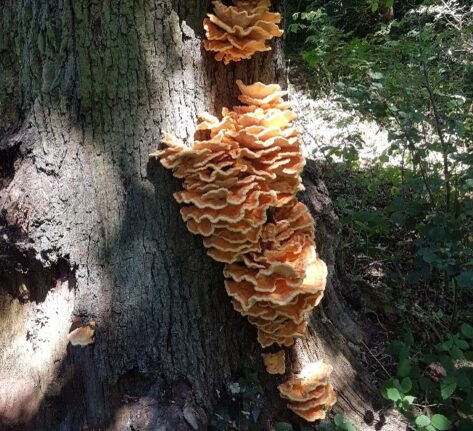
Laetiporus sulphureus
Chicken of the Woods
Perhaps one of the most recognisable of all British fungi, Laetiporus sulphureus is a distinctive bright yellow to orange coloured bracket that fades to off white with age. It is a fleshy, annual bracket with
fruitbodies generally appearing from May until October, sometimes lasting a month or more. The pore layer, on the underside of each bracket, is often almost entirely smooth in appearance when young, with pores only appearing to the naked eye as the bracket matures.
There are no obvious lookalikes for this distinctive fungus, except perhaps the giant polypore (Meripilus giganteus), which grows from the base of trees and blackens with age. However, it is likely that there are several cryptic species present in the UK. We are conducting research into the current species diversity of Laetiporus, so If you notice a bracket with a pure white pore layer and bright orange cap, as opposed to the usual yellow pore layer, or if you notice other unusual characteristics, please tell us about them and take good photographs when submitting your records.
Laetiporus fruit bodies are important habitat for many insects, especially species of beetle like the hairy fungus beetle (Pseudotriphyllus suturalis).
This is one of the key heart-rot species on oak, causing a brown rot that eventually creates hollows that can be very rich in biodiversity.
Fistulina hepatica
Beefsteak fungus
We currently believe Fistulina hepatica to be the most important of the heart-rot fungi on oak, causing a brown rot that creates hollows from the dead heartwood.
This is another fleshy, annual bracket often with a moist surface. The top of each bracket ranges from pale foamy pink when young, through to rich reds and browns, reminiscent of internal organs like livers or hearts, as the bracket ages. A slice through this soft fruit body will reveal a veined flesh like context, which when squeezed will produce droplets of red exudate, making the common name ‘beefsteak fungus’ very
fitting.
With these strong features it is an easy fungus to identify and is very common on older oaks.

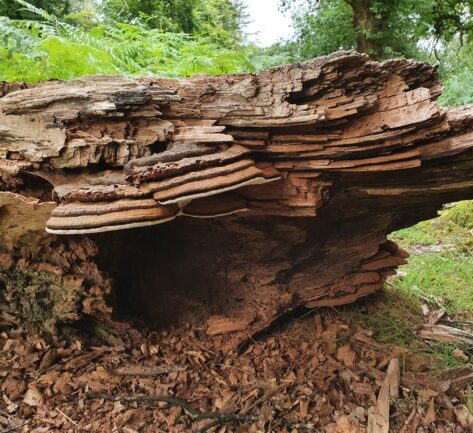
Ganoderma spp.
Bracket fungi
Species of Ganoderma are tough, woody, perennial brackets that can last for many years. They are white rotters of heartwood and in some cases, they are also parasitic on their host trees, attacking sap wood and roots.
They can have shiny, resinous caps, ranging from dark black through to fantastic orange and red sunbursts when young, often fading to a brown, brick like colour with age. Their pore surface is always white while alive and fresh and in some cases is easily bruised dark brown by applying pressure or marking with a stick. There are a few different species that occur on oak, which can be hard to tell apart in the field. Most of the common ones occur as brackets, others such as Ganoderma lucidum, can occur with a stem.
Their spores are the colour of coco powder and can often be seen attached to plants or wood below the fruiting bodies.
Hymenochaete rubiginosa
Oak curtain crust
This is a common species of fallen oak wood but can also be found near wounds of living trees.
The curtain like brackets hang down over each other, often with many tiers in one location. Each has a dark base close to the substrate and a lighter, zonate margin made up of parallel bands in shades of brown.
The pore layer is dark and smooth, often with a lighter margin.
It is similar to some Stereum species, but its dark colouring, overlapping tiers, and brackets that do not have a pore layer that runs down the woody substrate, help to separate it from these species.
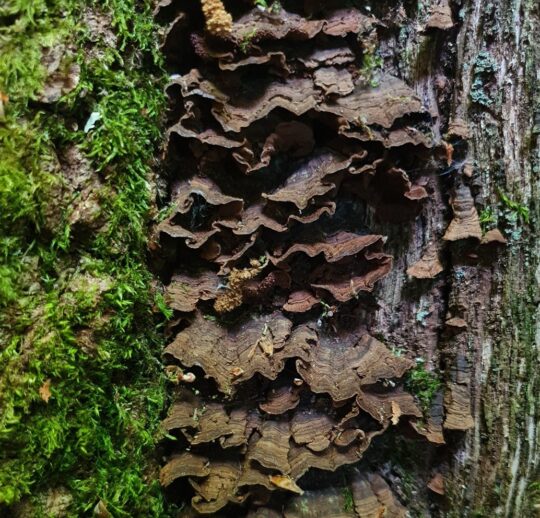
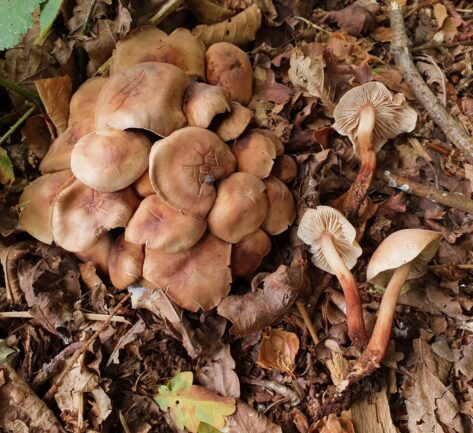
Gymnopus fusipes
Spindle toughshank
Gymnopus (Collybia) fusipes is a fungus that can be found at the base of oak trees, attached to roots that it is decaying beneath the soil.
It grows densely in clusters often arising from a small area. When a single fruitbody is gently pulled out of the soil it will reveal a long, tapered base to the tough and fibrous stem. These are pale gilled fungi with white spores that can sometimes be found deposited on the caps of fruitbodies that
are lower in the cluster. The stems fade from reddish browns in the base through to cream towards the gills.
The clustering (fasciculate) growth and tough, tapering stem are good field characters for this fungus.
Gymnopus fusipes is notorious for causing the early death of oak trees due to the rotting of roots that are essential to strengthening a large old tree against wind blow.
Daedalea quercina
Oak mazegill
This tough, perennial bracket gets its common name from the large and labyrinth like pores on its under surface. It is a common white rot fungus on oak and occasionally other broadleaved trees.
It ranges in colour from creamy buff through to pale browns and can take on a deceptive array of forms. Sometimes it will occur as solitary semi-circular brackets, other times in a semi-conical form and also as patches of conjoined brackets with a shared pore surface (effused).
It is most often found on dead wood, but can also be seen on partly decayed living trees.
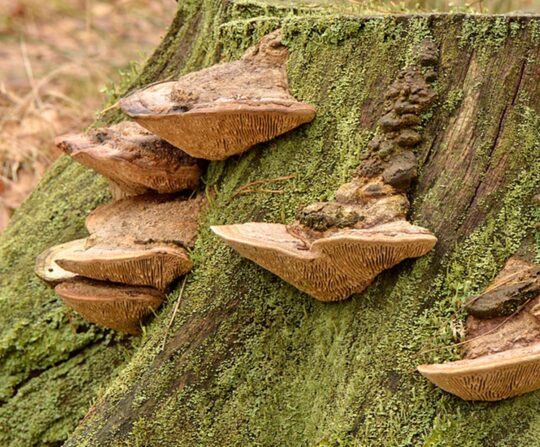
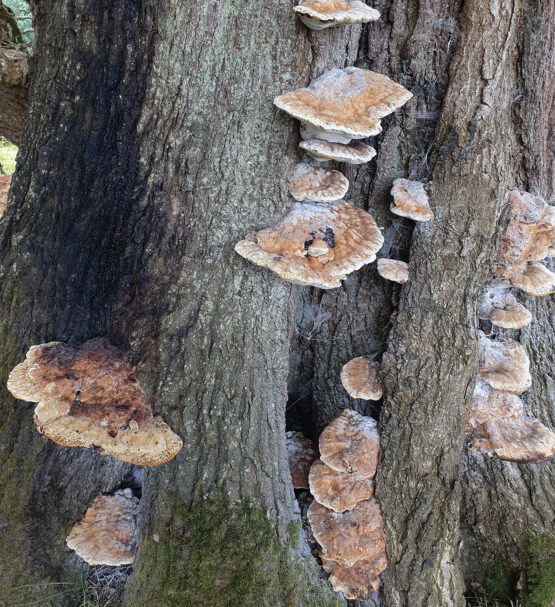
Pseudoinonotus dryadeus
Oak bracket
Often a large and tough bracket, Pseudoinonotus dryadeus exudes amber droplets from the growing regions of the fungus. This occurs all over the surface when young and just around the advancing margin when older. This can be especially notable and beautiful in freshly emerging specimens.
This white rotting fungus decays heartwood but is also known to be capable of invading sap
This fungus is predominantly found at the base of trees, often where the butt reaches the soil surface, but can also be found higher up.
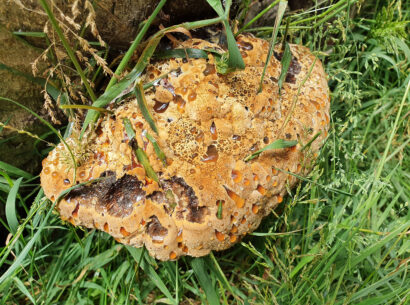
Grifola frondosa
Hen of the woods
Grifola frondosa is a short-lived firm, but fleshy polypore, that grows at the base of broadleaved trees such as oak and beech. This fungus attacks living trees often causing extensive white rot in the roots.
Its many wave like crests, brown upper surface and smooth white pore layer are distinctive. Another similar fungus, Meripilus giganteus (blackening polypore) can be separated from this species by its larger lobes, more yellowish colours and that is blackens when bruised or with age. Cauliflower fungi in the genus Sparassis are more evenly and finely lobed, over all dome shaped, and lack the darker brown colouring.
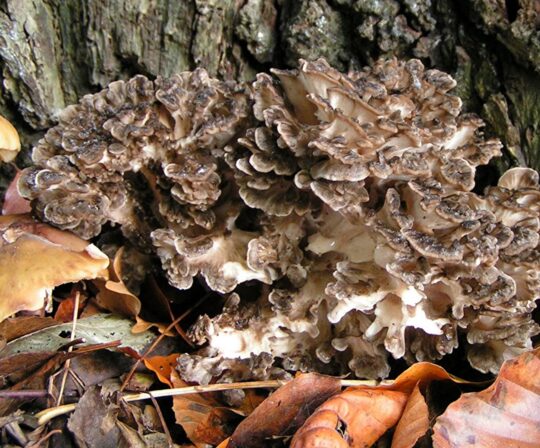
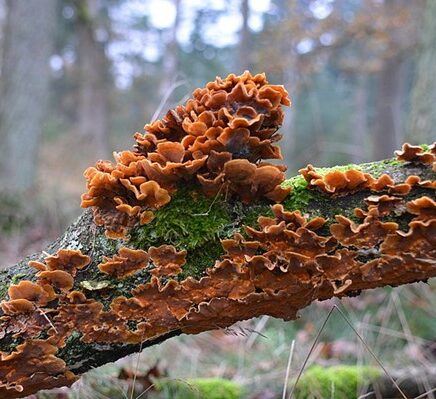
Stereum spp.
Crust fungi
Stereums are fungi that grow as tiers of reflexed thin brackets extending from a smooth and often conjoined pore layer. They are somewhere between a resupinate crust and a small bracket. There are a few species that can be found on oak and they are not easy to separate for beginners. We are happy with an identification to genus level and some good photos. However, a good field guide should be enough help to guide you to a clear identification in some cases.
The species pictured above is Stereum gausapatum (bleeding oak crust), which can often be found on oak branches and is also known to decay heartwood. When cut with a knife or dug into with a fingernail
it bleeds a dark red latex, hence the common name, bleeding oak crust.
Buglossoporus quercinus
Oak polypore
This rare, annual bracket fungus is one of the few protected species of fungi in the UK. It is usually known from ancient or veteran oak trees, where it can be found decaying their heartwood, but it can also occasionally be found on younger trees where damage has exposed interior.
It produces fleshy, flattened, slightly convex brackets that can be fan shaped to rounded, that become tougher and lighter with age. They start off whitish with yellow tinges and then brown on the upper surface as they age. The pore surface is smooth and white, but bruises and ages to a dirty brown.
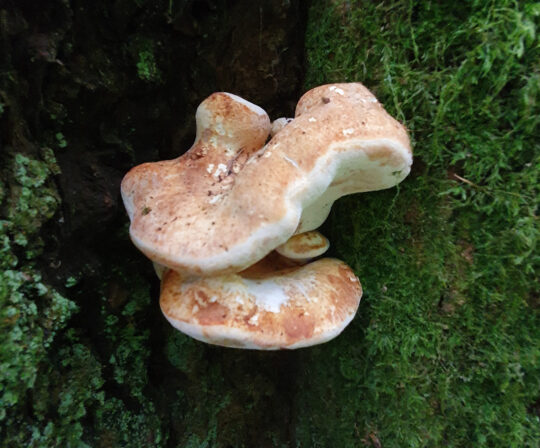

Armillaria spp.
Honey fungi
Species of Armillaria are notorious amongst gardeners and foresters as they pose a serious threat to living trees. They often attack through white rot of the roots, eventually undermining the trees stability or reducing its ability to draw enough nutrients, either often resulting in death of the
tree. The fungus then continues as a saprotroph breaking down the dead wood.
These fungi can occur in dense clusters or as scattered solitary fruitbodies, depending upon which species it is. Identification can be difficult, so we are happy with genus level for this group.
A distinctive feature of the Armillaria species that can be found on oak, is their black rhizomorphs which can be found working their way under bark and through the surrounding soil. These melanised conduits serve as an armour-plated corridor for the fungus to safely grow along, protected from insect damage, the elements and competitor fungi.
The fruit bodies all have light to mid golden-brown caps that have a finely scaley surface. Their gills are pale, and the spore print is white. They all have a ring on the stem, apart from Armillaria tabescens,
the ringless honey fungus.
Trametes spp.
Turkey tails
Turkeytail fungi can be found throughout the year and occur in a diverse range of banded colours that can vary widely within species. The common species, Trametes versicolor, pictured above can be found on the wood of many broadleaved species throughout the temperate world.
There are several similar species in this genus, with similar zonation patterns, ranging from cream, through ochres to velvety greens and blues.
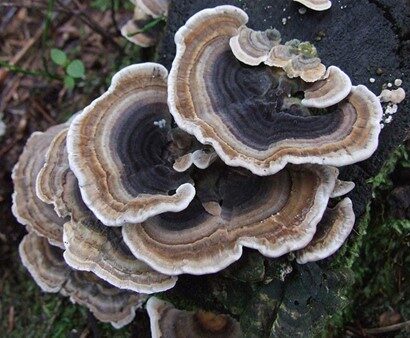

Pleurotus dryinus
Veiled oyster
This uncommon and beautiful oyster fungus can be found on living or dead hardwood trees, often oak or beech. It often fruits in small numbers but can occasionally be found in larger groupings.
Unlike other species of Pleurotus, the veiled oyster has a partial veil, the remnants of which can be seen around the cap margin in the picture above. This oyster fungus also has a felty or scaley cap a feature not seen in other members of the genus present in the UK.
The pale cream fruitbody, decurrent gills and veil make this an uncommon fungus that is easy to identify.
Pleurotus ostreatus
Grey oyster
One of the more common fungi to be found on dead wood and one well known amongst fungus enthusiasts, Pleurotus ostreatus, is a fleshy shelf like mushroom, with a brown to grey cap and strongly decurrent gills that often run all the way down their short stems.
It can be found on living and dead trees and fallen wood andoften produces fruit bodies more than once a year.
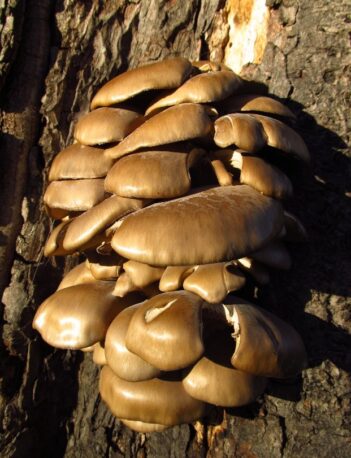
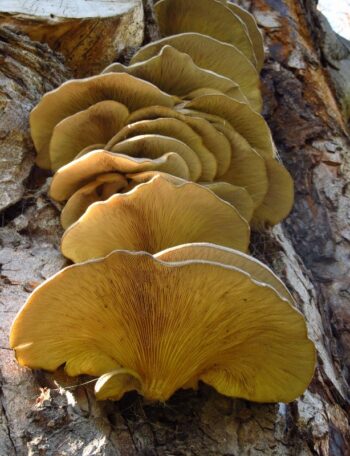
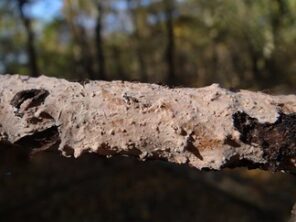

Peniophora quercina
Oak Crust
Peniophora quercina is a resupinate crust fungus that often occurs on dead wood of oaks but can also be found on living trees. It is a white rotter and is generally regarded as a pioneer species on dead wood.
This species changes appearance depending on whether it is wet or dry, ranging from adpressed pink patches that envelop the surface in dap conditions, through to broken grey or lilac islands with curled in edges when dry.
Phellinus, Fomitiporia, and Fuscoporia spp.
Pore crusts
Phellinus, Fomitiporia, and Fuscoporia species are mainly white rotters that are found on wood and can take many different forms, from flat cushion like crusts, through to entire brackets. This makes them a difficult group for beginners to identify and hence we have grouped all of the pore crusts together in simple mode.
A useful character in this group is the pore layer, which may be all there is to see of a fruiting body that is adpressed to the surface of the wood or in other cases may be on the underside of a bracket. The pore layer is often a rich orange to cinnamon brown colour and the pores are visible to the naked eye with around 5 per millimetre.
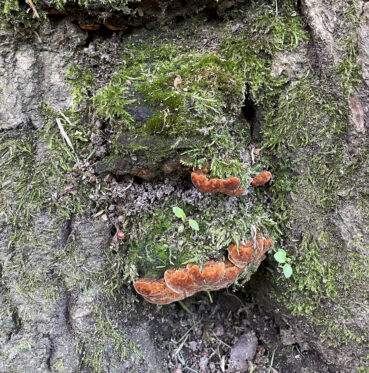
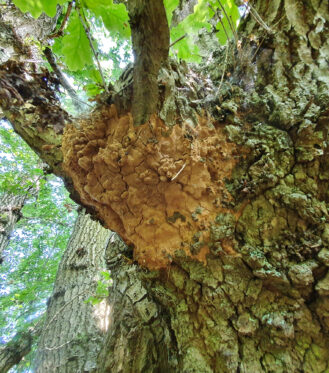
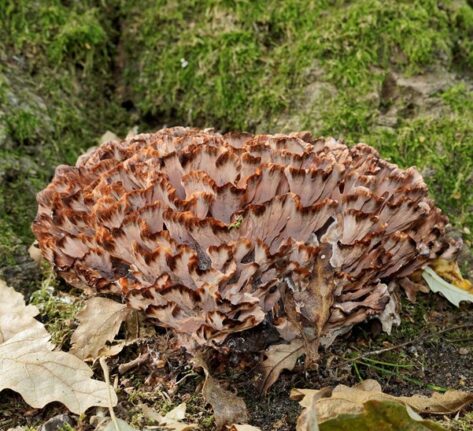
Podoscypha multizonata
Zoned rosette
TPodoscypha multizonata is a rare and beautiful fungus that can be found at the base of oak trees. It appears to only be known from the southern UK, with a concentration of records in the south east.
This is a highly distinctive fungus, with pale pinkish lobes that form a dense rosette. The tips of each lobe end in a darker margin.
Similar species include Grifola frondosa (mentioned above) which does not form a rosette like structure and lacks the pinkish tones.

